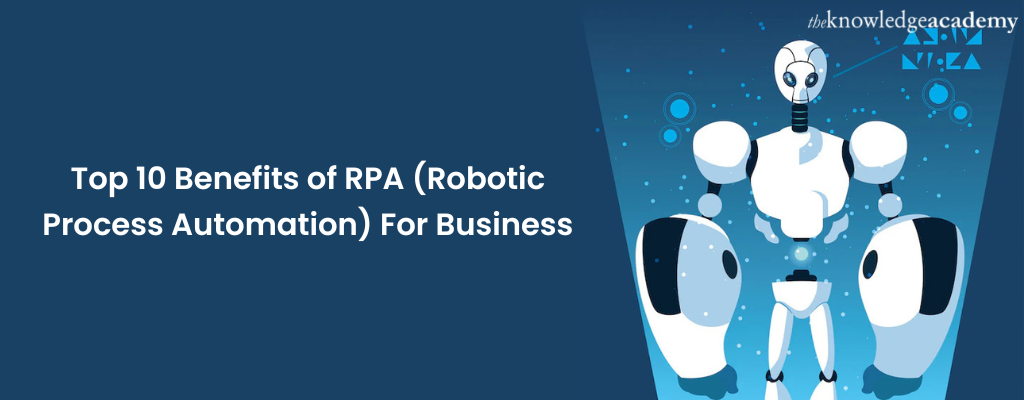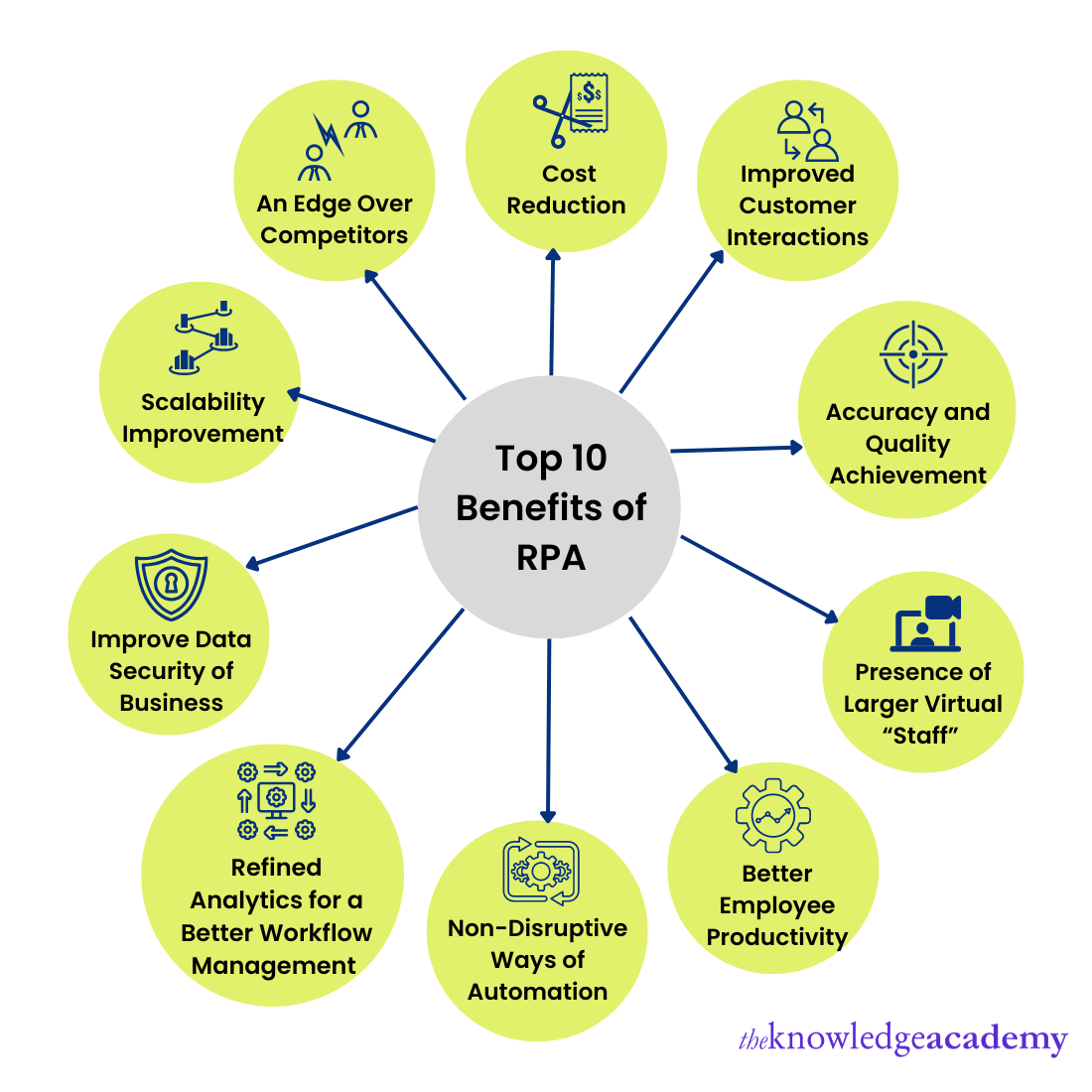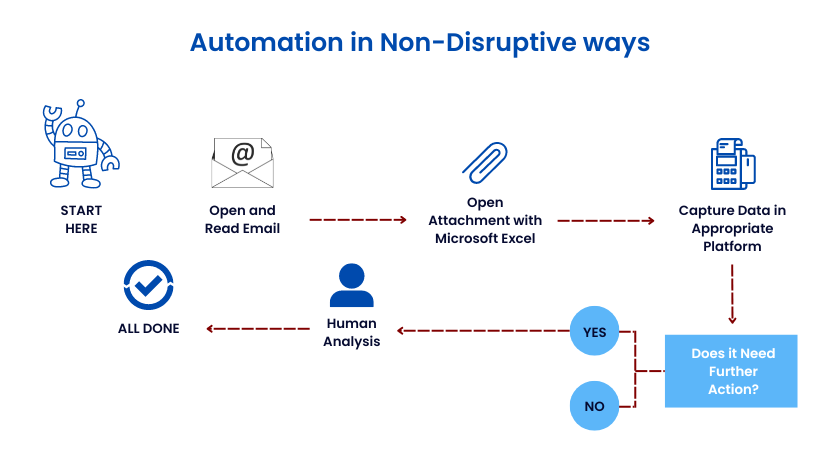We may not have the course you’re looking for. If you enquire or give us a call on 01344203999 and speak to our training experts, we may still be able to help with your training requirements.
Training Outcomes Within Your Budget!
We ensure quality, budget-alignment, and timely delivery by our expert instructors.

Robotic Process Automation (RPA) has become one of the most sought-after technologies in recent years, contributing to businesses' productivity for long-term success. One of the Benefits of RPA is to perform tasks across business systems and organisations in a similar way as human professionals do. For tasks that are repeatable, routine, and rules-based, for instance, acquiring customer data from various business systems and checking the completeness of a form, RPA software robots are exceptionally great at performing such tasks.
RPA helps improve efficiency and accuracy in business processes, thereby leaving human working teams who spend their time on repetitive and mundane tasks. It has been that currently, employees performing repetitive computer tasks spend around 10-25% of their time, and IT departments spend about 30% of their time on basic low-level tasks. In this blog, you will learn about a software technology called a Robotics Process Automation (RPA) and its benefits in business.
Table of Contents
1) What are the Benefits of RPA?
a) Cost Reduction
b) Improved Customer Interactions
c) Accuracy and Quality Achievement
d) Presence of Larger Virtual “Staff”
e) Better Employee Productivity
f) Non-Disruptive Ways of Automation
g) Refined Analytics for a Better Workflow Management
h) Improve Data Security of Business
i) Scalability Improvement
j) An Edge Over Competitors
2) Conclusion
What are the benefits of RPA

The Benefits of RPA are widespread and significant. You can use software robots to achieve remarkable and measurable improvements in areas of your business ranging from customer satisfaction to engagement of employees, so that it leads to speedy processes, accuracy, and cost efficiency. Be ready to give an in-detail answer when your manager or CTO asks, “What is the need for RPA”? Start by looking below at some of the advantages of RPA:

Cost Reduction
It has been observed that by using robotics, operational costs are cut by 25-50% approximately. Robots can work twenty-four hours a day and seven days a week with no vacations compared to humans, who can work only eight to nine hours a day and have a fixed number of leaves yearly. The presence of robots taking over some of the work done manually by humans could result in visible outcomes in the form of profits for the business. Within a short time, automation can help you recover the cost; after that, it is only about gains.
Improved Customer Interactions
Customer service is generally a high-maintenance, high-commitment process that requires tremendous time and attention from the organisation's employees. This challenge is overcome by Robotic Process Automation, which can move processes quickly and much more efficiently than professional staff. As a result, a business is expected to see the level of customer satisfaction grow considerably higher. This is because, with the presence of low-level requests of the customer, which are handled automatically, such customers will have a better experience leading to greater loyalty.
Accuracy and Quality Achievement
The third advantage of RPA is that it offers improvised services to processes where humans tend to make errors, resulting in increased accuracy. This is because robots when expected to work tirelessly, do not whine or complain and are considered reliable and consistent. Secondly, they bring down the case of re-works and improvise the output quality. This is because robots follow all the rules completely, producing 100 per cent accuracy in the process results. RPA also can optimise processes which result in the multiplication of organisational capacity.
Presence of Large Virtual “Staff”
In many cases, by using RPA, businesses can get many things done with fewer workers. There is a high possibility that by adopting RPA automated workers, businesses have considered working with a smaller staff; or lowered the pace of hiring new human staffers. In any case, a well-governed group of automated virtual workers will significantly expand your total number of workers. This large group of virtual "Staff" will be working hard all day in a week, needs no vacation time, and in any case, will not leave any mess on the company's dining premises.
Better Employee Productivity
RPA encourages both humans and robots to do things that they excel at. Since RPA eliminates mundane activities from the employees, the employees can focus more on client and customer interaction, building on relationship management and other probable activities where humans can naturally be successful. Organisations having satisfied clients and customers means better businesses for them.
Non-Disruptive Ways of Automation

Automation is part of the investment for doing business in any brand-new company. Whereas for organisations that are well established and have grown and evolved over many years, automation of legacy systems might be risky. Yet RPA tools based on platforms that require no coding do not need you to replace all existing legacy systems. Rather, it is simpler to train most of the robots on a legacy software since these tools are designed to mimic human user interactions, for instance, clicks and keystrokes.
Refined Analytics for a Better Workflow Management
Several tracking systems, such as workflow analytics, are available for monitoring human staff. A clear framework of activities and timelines can be set up, and the effectiveness of the RPA tool can be traced down to the minor task and the smallest time increment. In addition, by continuously tracking the RPA system's activities and achievements, the planning and governance can be increased by a metric that gives precision and clarity.
The analytics will become more complex as RPA becomes more intelligent since Machine Learning (ML) and Artificial Intelligence (AI) are already built into an automated process. However, if given to the right Data Scientist professional, the system can still track the performance with complete authority.
Improve Data Security of Business
A main concern that the organisation's leaders express about the potential use of RPA tools is the impact on operational risk. Some common risks, such as Data leaks and breaches, already exist, and management may raise a concern about the security of such systems. But the risk of data leaks between platforms is relatively minor when your team carefully manages and stringently defines RPA parameters. Greater confidence in security is maintained by selecting a well-developed and maintained solution.
In places with strict personal data regulations, using RPA provides favourable opportunities for decreasing the number of human touches when businesses require to process personal information. You can attain compliance and easier execution of governance practices when you enable this pullback and reduce contact with sensitive data.
Get familiar with acquiring the necessary skills for launching Blue Prism interactive clients. Register for our Blue Prism Training course now!
Scalability Improvement
RPA solutions are tailored for ease of scalability because a human team of Professionals can never achieve the scope and reach of competitive activities at a level where an army of automated robots is present. Indeed, when it comes to scalability, the two trams – humans and bots are not even close to each other. For example, a group of automated robotic processes can be duplicated and programmed to achieve a similar but slightly different set of procedures. The process of duplication and reprogramming can repeatedly occur, producing a unit of active systems, which were once a handful.
An Edge Over Competitors
Given that RPA has the power of being scalable and a highly flexible Automation, any business or organisation with the potential to deploy will have a sizeable amount of performance advantage over its competitors that do not employ such a system. The ability of RPA to quickly and accurately perform a wide range of essential tasks makes a business much more flexible and likely to complete an aggressive task load.
Conclusion
After reading this blog, we hope you can now appreciate the Benefits of RPA. With the opportunities to work smarter and quicker, RPA is revolutionising process efficiencies and increasing organisational productivity by changing how various business models are run. By incorporating RPA into a complete platform for intelligent automation, you can remove the legacy system while creating a unified approach to processes and data analysis.
Learn how to become familiar with fundamental concepts of UI Automation by registering for our Robotic Process Automation Using UiPath course now!
Frequently Asked Questions
Upcoming Business Analysis Resources Batches & Dates
Date
 Robotic Process Automation using UiPath
Robotic Process Automation using UiPath
Thu 9th May 2024
Thu 27th Jun 2024
Thu 18th Jul 2024
Thu 12th Sep 2024
Thu 7th Nov 2024
Thu 12th Dec 2024







 Top Rated Course
Top Rated Course


 If you wish to make any changes to your course, please
If you wish to make any changes to your course, please


